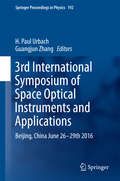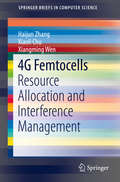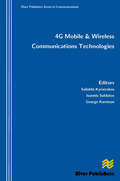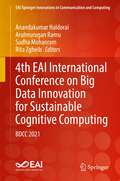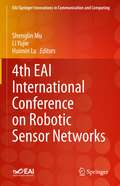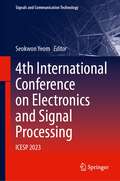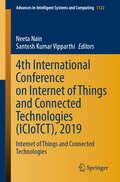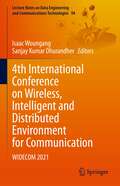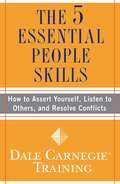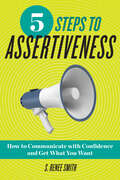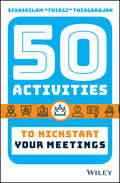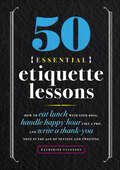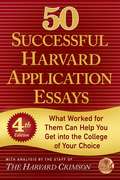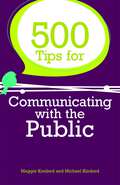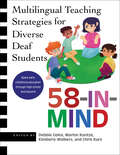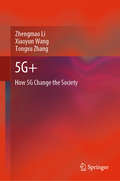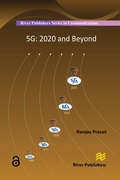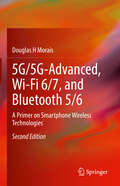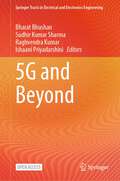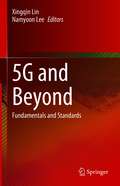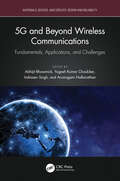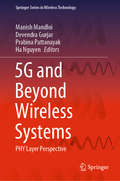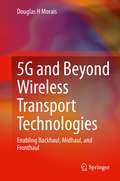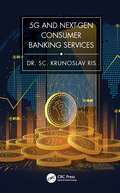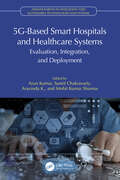- Table View
- List View
3rd International Symposium of Space Optical Instruments and Applications: Beijing, China June 26 - 29th 2016 (Springer Proceedings in Physics #192)
by H. Paul Urbach Guangjun ZhangThis volume contains selected and expanded contributions presented at the 3rd Symposium on Space Optical Instruments and Applications in Beijing, China June 28 - 29, 2016. This conference series is organised by the Sino-Holland Space Optical Instruments Laboratory, a cooperation platform between China and the Netherlands. The symposium focused on key technological problems of optical instruments and their applications in a space context. It covered the latest developments, experiments and results regarding theory, instrumentation and applications in space optics. The book is split across five topical sections. The first section covers space optical remote sensing system design, the second advanced optical system design, the third remote sensor calibration and measurement. Remote sensing data processing and information extraction is then presented, followed by a final section on remote sensing data applications.
4G Femtocells: Resource Allocation and Interference Management (SpringerBriefs in Computer Science)
by Xiaoli Chu Haijun Zhang Xiangming WenThis brief examines resource allocation and interference management for 4G femtocells. It introduces 4G femtocells in the context of 4G mobile networks and discusses related technical challenges in resource allocation and interference management. Topics include ant colony algorithm based downlink resource allocation, intelligent scheduling and power control, uplink and downlink for two-tier networks, quality of service (QoS) constraints and the cross-tier interference constraint. The authors present algorithms to alleviate common femtocell-related problems such as subchannel power allocation. The complexity of the proposed resource allocation algorithms is analyzed, and the effectiveness of the proposed algorithms is verified by simulations. This concise and practical book directly addresses common problems relating to femtocells and resource management. It serves as a useful tool for researchers in the field. Advanced-level students or professionals interested in femtocells and networks will also find the content helpful.
4g Mobile and Wireless Communications Technologies (River Publishers Series In Communications Ser.)
by Sofoklis Kyriazakos Ioannis Soldatos George KaretsosMobile and wireless communications are moving towards a new era that will be characterized by the seamless collaboration of heterogeneous systems, the need for high speed communications while on the move and for advanced services with quality guarantees. Recent market research studies show that most of the traffic in the future wireless networks will be produced by mobile multimedia services which are expected to proliferate by the year 2010. On the other hand mobile and wireless communications technology is becoming more and more important in developing countries where people demand fast deployment and low cost for broadband wireless internet services.The objective of this volume is to gather research and development on topics shaping the fourth generation (4G) in mobile and wireless communications and reveal the key trends and enabling technologies for 4G. We envisage 4G wireless communication systems as IP based solution providing integrated services (voice, data, multimedia) regardless of time and end-users? location. 4G technologies will manifest the benefits of the wireless and wired technologies convergence, through enabling a wide range of innovative (both indoor and outdoor) applications. 4G applications will feature premium quality, high security and an affordable cost. The vision, though fantastic, is associated with a host of technical and technological challenges.A great deal of the latter are discussed in the articles of this volume, which aims at providing insights on the research issues and solutions that are directly associated with leading edge 4G technologies and services.Taking into account recent developments in the world of wireless communications we have given emphasis to cover all these technologies and aspects that are considered as cornerstones for achieving the goals set for 4G and that will further boost research and development of next-generation mobile communications.
4th EAI International Conference on Big Data Innovation for Sustainable Cognitive Computing: BDCC 2021 (EAI/Springer Innovations in Communication and Computing)
by Anandakumar Haldorai Arulmurugan Ramu Sudha Mohanram Rita ZgheibThis book features the proceedings of the 4th EAI International Conference on Big Data Innovation for Sustainable Cognitive Computing (BDCC 2021). The papers feature detail on cognitive computing and its self-learning systems that use data mining, pattern recognition and natural language processing (NLP) to mirror the way the human brain works. This international conference focuses on technologies from knowledge representation techniques and natural language processing algorithms to dynamic learning approaches. Topics covered include Data Science for Cognitive Analysis, Real-Time Ubiquitous Data Science, Platform for Privacy Preserving Data Science, and Internet-Based Cognitive Platform.
4th EAI International Conference on Robotic Sensor Networks (EAI/Springer Innovations in Communication and Computing)
by Shenglin Mu Li Yujie Huimin LuThis book presents papers presented at the 4th EAI International Conference on Robotic Sensor Networks. The conference explored the integration of networks and robotic technologies, which has become a topic of increasing interest for both researchers and developers from academic fields and industries worldwide. The authors explore how big networks are becoming the main tool for the next generation of robotic research, owing to the explosive number of networks models and the increased computational power of computers. The papers discuss how these trends significantly extend the number of potential applications for robotic technologies while also bringing new challenges to the networks’ communities. The 2nd EAI International Conference on Robotic Sensor Networks was held online on November 21-22, 2020.
4th International Conference on Electronics and Signal Processing: ICESP 2023 (Signals and Communication Technology)
by Seokwon YeomThis book presents the proceedings of the 4th International Conference on Electronics and Signal Processing (ICESP 2023), which was held in Macau, China during January 13-15, 2023. The book consists of contributions from various authors from both academia and industry, focusing on a diverse aspect of signal processing and information communication systems. The published papers suggest cutting-edge solutions that contribute to the quest for the future applications and communicating systems. The book is a useful reference to research students, research fellows, and scientists and engineers in the corresponding fields.
4th International Conference on Internet of Things and Connected Technologies: Internet of Things and Connected Technologies (Advances in Intelligent Systems and Computing #1122)
by Neeta Nain Santosh Kumar VipparthiThis book presents the proceedings of the 4th International Conference on Internet of Things and Connected Technologies (ICIoTCT), held on May 9–10, 2019, at Malaviya National Institute of Technology (MNIT), Jaipur, India. The Internet of Things (IoT) promises to usher in a revolutionary, fully interconnected “smart” world, with relationships between objects and their environment and objects and people becoming more tightly intertwined. The prospect of the Internet of Things as a ubiquitous array of devices bound to the Internet could fundamentally change how people think about what it means to be “online”. The ICIotCT 2019 conference provided a platform to discuss advances in Internet of Things (IoT) and connected technologies, such as various protocols and standards. It also offered participants the opportunity to interact with experts through keynote talks, paper presentations and discussions, and as such stimulated research. With the recent adoption of a variety of enabling wireless communication technologies, like RFID tags, BLE, ZigBee, embedded sensor and actuator nodes, and various protocols such as CoAP, MQTT and DNS, IoT has moved on from its infancy. Today smart sensors can collaborate directly with machines to automate decision-making or to control a task without human involvement. Further, smart technologies, including green electronics, green radios, fuzzy neural approaches, and intelligent signal processing techniques play an important role in the development of the wearable healthcare devices.
4th International Conference on Wireless, Intelligent and Distributed Environment for Communication: WIDECOM 2021 (Lecture Notes on Data Engineering and Communications Technologies #94)
by Isaac Woungang Sanjay Kumar DhurandherThis book presents the proceedings of the 4th International Conference on Wireless Intelligent and Distributed Environment for Communication (WIDECOM 2021), which took place at University of KwaZulu-Natal, South Africa, October 13-15, 2021. The book addresses issues related to new dependability paradigms, design, and performance of dependable network computing and mobile systems, as well as issues related to the security of these systems. The main tracks include infrastructure, architecture, algorithms, and protocols. The goal of the conference is to provide a forum for researchers, students, scientists and engineers working in academia and industry to share their experiences, new ideas and research results in the above-mentioned areas.
The 5 Essential People Skills: How to Assert Yourself, Listen to Others, and Resolve Conflicts
by Dale Carnegie TrainingFrom one of the most trusted and bestselling brands in business training and throughout the world, The 5 Essential People Skills shows how to deliver a message to others with power and clarity, how to build loyalty and inspire creativity by demonstrating assertiveness, and how to be assertive.Put these five essential skills to work and begin your transformation! Have you ever walked away from a conversation full of doubts and insecurities? Do you feel as if you've lost a little ground after every staff meeting? Most of us are either too passive or too aggressive in our business life, and we end up never getting the support, recognition, or respect we desire. The business leaders and trainers from Dale Carnegie Training have discovered that applying appropriate assertiveness to all your interactions is the most effective approach to creating a successful career. The 5 Essential People Skills will help you be the most positively commanding, prosperous, and inspired professional you can be. You will learn how to: · Relate to the seven major personality types· Live up to your fullest potential while achieving personal success · Create a cutting-edge business environment that delivers innovation and results · Use Carnegie's powerhouse five-part template for articulate communications that grow business· Resolve any conflict or misunderstanding by applying a handful of proven principles Once you master these powerful skills, you will be well on your way to a new level of professional and personal achievement.
5 Steps to Assertiveness: How to Communicate with Confidence and Get What You Want
by S. Renee Smith5 Steps to Assertiveness is the modern how-to guide to communicate with assertiveness and build stronger relationships in today's world. Assertiveness goes beyond standing up for yourself. Assertiveness is saying what you want in a way that makes others want to listen. This philosophy is at the heart of the self-development method created by nationally recognized self-esteem and communication expert S. Renee Smith. In 5 Steps to Assertiveness, the nationally recognized self-esteem and communication expert distills what she's learned and taught about assertiveness over the past 20 years into 5 easy-to-follow steps. Built on her successful engagement with hundreds of organizations and individual clients, S. Renee has curated this actionable 5-step how-to guide that will help you see the value of what you have to say— and gain the confidence to say it. 5 Steps to Assertiveness is the most current guide to persuasive communication, and includes: A 5-step assertiveness action plan to help you understand your communication style and identify changes you can make that will lead to greater assertiveness An overview of the 4 different communication styles and the benefits and challenges of changing yours Practical exercises and examples that lead to real-world assertiveness in personal and professional situations When you communicate with assertiveness, you control where you go, how far you go, and the shape you're in when you get there. With 5 Steps to Assertiveness, the power is in your hands.
50 Activities to Kickstart Your Meetings
by Sivasailam ThiagarajanInfuse creativity, collaboration, and optimism into every meeting Dr. Sivasailam "Thiagi" Thiagarajan is an internationally recognized expert in effective group communication. He is known for engaging diverse participants at some of the world's leading organizations. In 50 Activities to Kickstart Your Meetings, Thiagi reveals his most effective "Group Performance Support" tools—tried and tested activities that will get your meeting participants thinking, talking, and collaborating like never before. We aren't born knowing how to lead and participate effectively in meetings. Our meeting participants want to engage and generate results just as much as we do—but first we need to teach them how. This book's enjoyable activities will help people reach their collaborative potential, and they'll have fun doing it! Whether you are facilitating meetings with 2 people or 200 people (or more!), and whether you have 2 minutes or 2 hours to fill, this book has an activity to fit. Get your participants engaged and turn them into active stakeholders in all aspects of the meeting process—from morale building and inclusivity to more productive discussions and creative collaboration, 50 Activities to Kickstart Your Meetings covers it all. An indispensable resource for anyone who wants to transform meetings into engines of creativity and growth!
50 Essential Etiquette Lessons: How to Eat Lunch with Your Boss, Handle Happy Hour Like a Pro, and Write a Thank You Note in the Age of Texting and Tweeting
by Katherine FurmanStay cool in any situation with this modern manners guide.Meeting strangers at a party, alone in the elevator with the CEO, declining a second date because the first was a disaster—social situations apply a lot of pressure to do and say the right thing. 50 Essential Etiquette Lessons shows you the best way to approach these common challenges with confidence and ease. Never mind putting your pinkies up when you drink tea—this guide is packed with modern examples of how to handle any sticky situation.Short, easy lessons cover workplace etiquette, to help you come across as an on-point, put-together asset to any company. Learn specific strategies for performing your best in social settings, both in person and online. Master skills like keeping conversation going, showing your best side on social media, giving gifts appropriately, and more.50 Essential Etiquette Lessons includes:50 indispensable tips—Get etiquette advice for dining out with friends, navigating a networking event, celebrating special occasions, and more.Updated manners—No need to be fussy or formal—this is practical, straightforward etiquette for today.Real-life examples—Tackle tricky scenarios with the help of a Q&A chapter that shows you how to use etiquette confidently every day.With 50 Essential Etiquette Lessons, embarrassing missteps and awkward silences will be a thing of the past.
50 Successful Harvard Application Essays Fourth Edition
by The Staff of The Harvard CrimsonThis book gives you the most inspiring approaches, both conventional and creative, that won over admissions officers at Harvard University, one of the nation's top ranked colleges.
500 Tips for Communicating with the Public
by Michael Kindred Maggie KindredThis is a light-hearted, easily digestible guide with a wealth of handy hints and tips for communicating with the public. For those in the helping professions, communicating with the public can sometimes be a challenge, and different skills are needed to those used when communicating with friends and family. This book addresses these issues by providing hundreds of tips on how to communicate with the public, covering topics such as managing conflict, assertiveness, feelings, listening and boundaries. It also includes guidance on reflection, supervision, confidentiality and anti-discrimination. The book uses a fun and accessible approach, making the advice easy to read and then put into practice. This handy guide will be invaluable to a range of practitioners in the helping professions including health visitors, social care workers, probation officers and teachers, as well as any other professional looking for tips on how to communicate effectively.
58-IN-MIND: Multilingual Teaching Strategies for Diverse Deaf Students
by Debbie Golos; Marlon Kuntze; Kimberly Wolbers; Chris KurzA highly practical and engaging resource for current and future teachers, 58-IN-MIND describes and demonstrates theoretically-driven, research-based, and classroom-tested best practices for using American Sign Language and English in instruction across the curriculum. The multilingual and multimodal instructional strategies presented here are embedded in approaches that aid learning and foster well-being. This book will support teachers in creating meaningful educational experiences for Deaf students in all grades, from early childhood education through high school. Each chapter is written by a team of researchers and P–12 teachers with at least one Deaf coauthor. With seventy-five percent of the authors being Deaf, this is the first teaching methods book to harness the expertise of Deaf professionals at this level, highlighting their vital role in Deaf education and in shaping inclusive and effective learning environments. This book meets the need for a resource that recognizes the diversity of Deaf students by creating space in the classroom to honor their home/heritage languages, cultures, races, genders, abilities, hearing levels, and other multiple and intersecting identities. Written in a conversational tone, the book includes core recommendations for instruction of the targeted subject area, examples of key strategies, lessons and real stories from those working in the field, suggestions for practice, and recommended resources. “58-IN-MIND” in the title refers to the version of the ASL sign "stick" that is made on the forehead, which is equivalent to the English idiom “to stick in one's mind.” As in, when students learn in a culturally responsive manner, the learning is likely to stick. The title also alludes indirectly to the collective aspirations of the chapter authors that the practices discussed in the book will also stick in the readers’ minds, and thus have a transformative impact on the way Deaf students are taught.
5G+: How 5G Change the Society
by Zhengmao Li Xiaoyun Wang Tongxu ZhangThis book takes China Mobile's "5G +" plan as the mainline, introduces three major scenarios, nine indicators, system architecture and basic principles of 5G, and systematically explains the essence of China Mobile's "5G +" for the first time. A lot of industry use cases and solutions are introduced for 5G to bring new changes to life, industries, and social governance. This book can benefit all readers who are interested in 5G. It also can be a reference for vertical industry partners to fully understand the possible applications of 5G. Most of all, it will help to promote all industries with new developments based on 5G's new kinetic energy.
5G: 2020 And Beyond (River Publishers Series In Communications Ser.)
by Ramjee PrasadThe future society would be ushered in a new communication era with the emergence of 5G. 5G would be significantly different, especially, in terms of architecture and operation in comparison with the previous communication generations (4G, 3G...). This book discusses the various aspects of the architecture, operation, possible challenges, and mechanisms to overcome them. Further, it supports users? interac- tion through communication devices relying on Human Bond Communication and COmmunication-NAvigation- SENsing- SErvices (CONASENSE).Topics broadly covered in this book are; • Wireless Innovative System for Dynamically Operating Mega Communications (WISDOM)• Millimeter Waves and Spectrum Management• Cyber Security• Device to Device Communication
5G/5G-Advanced, Wi-Fi 6/7, and Bluetooth 5/6: A Primer on Smartphone Wireless Technologies
by Douglas H MoraisThis second edition of this book provides, at a high level and in a tractable fashion, a description of how wireless communications are achieved in the latest smartphones. The author shows how smartphones communicate via three separate systems, namely 5G/5G-Advanced, Wi-Fi 6/7, and Bluetooth 5/6. The book explores how 5G/5G-Advanced allows mobile voice and high-speed data communication, how Wi-Fi 6/7 allows smartphone attachment to the Internet independent of 5G/5G-Advanced, and how Bluetooth 5/6 allows smartphone attachment to speakers, in-car entertainment systems, smart watches, etc. This text explains the key basic technologies employed and addresses how each system operates. In addition, a cursory overview is provided of smartphone GPS navigation and iPhone satellite messaging. This book is of interest to anyone with a rudimentary scientific understanding who desires to know more at an intuitive level, rather than at a rigorous one, how smartphones achieve wireless communications.
5G and Beyond (Springer Tracts in Electrical and Electronics Engineering)
by Bharat Bhushan Sudhir Kumar Sharma Raghvendra Kumar Ishaani PriyadarshiniThis open-access book aims to highlight the coming surge of 5G network-based applications and predicts that the centralized networks and their current capacity will be incapable of meeting the demands. The book emphasizes the benefits and challenges associated with the integration of 5G networks with varied applications. Further, the book gathers and investigates the most recent 5G-based research solutions that handle security and privacy threats while considering resource-constrained wireless devices. The information, applications, and recent advances discussed in this book will serve to be of immense help to practitioners, database professionals, and researchers.
5G and Beyond: Fundamentals and Standards
by Xingqin Lin Namyoon LeeThis book provides an accessible and comprehensive tutorial on the key enabling technologies for 5G and beyond, covering both the fundamentals and the state-of-the-art 5G standards. The book begins with a historical overview of the evolution of cellular technologies and addresses the questions on why 5G and what is 5G. Following this, six tutorial chapters describe the fundamental technology components for 5G and beyond. These include modern advancements in channel coding, multiple access, massive multiple-input and multiple-output (MIMO), network densification, unmanned aerial vehicle enabled cellular networks, and 6G wireless systems. The second part of this book consists of five chapters that introduce the basics of 5G New Radio (NR) standards developed by 3GPP. These include 5G architecture, protocols, and physical layer aspects. The third part of this book provides an overview of the key 5G NR evolution directions. These directions include ultra-reliable low-latency communication (URLLC) enhancements, operation in unlicensed spectrum, positioning, integrated access and backhaul, air-to-ground communication, and non-terrestrial networks with satellite communication.
5G and Beyond Wireless Communications: Fundamentals, Applications, and Challenges (Materials, Devices, and Circuits)
by Arumugam Nallanathan Indrasen Singh Abhijit Bhowmick Yogesh Kumar ChoukikerThis book provides a thorough introduction of 5G and B5G wireless networks, as well as cutting-edge technologies that aid in network design and development. This book also covers machine learning techniques for advanced communications.5G and Beyond Wireless Communications: Fundamentals, Applications, and Challenges discusses the newest technologies for 5G and future networks, including CR networks, D2D networks, UAV-assisted communications, RIS-assisted communications, and ML for communication networks. Additionally, it discusses using antenna systems for advanced communications networks. It also explores various security issues and their solutions, as well as power and interference management and machine learning for optimization of network parameters. The book also examines the design of 5G antennas from a materials perspective, and a thorough analysis of the materials utilized to create innovative antennas for advanced communication network is discussed. The book concludes by discussing the advancement of ML-based communication networks and their future opportunities and challenges.This book will be helpful for researchers and master students who want to focus their research work in the area of next-generation advanced wireless communications.
5G and Beyond Wireless Systems: PHY Layer Perspective (Springer Series in Wireless Technology)
by Manish Mandloi Devendra Gurjar Prabina Pattanayak Ha NguyenThis book presents the fundamental concepts, recent advancements, and opportunities for future research in various key enabling technologies in next-generation wireless communications. The book serves as a comprehensive source of information in all areas of wireless communications with a particular emphasis on physical (PHY) layer techniques related to 5G wireless systems and beyond. In particular, this book focuses on different emerging techniques that can be adopted in 5G wireless networks. Some of those techniques include massive-MIMO, mm-Wave communications, spectrum sharing, device-to-device (D2D) and vehicular to anything (V2X) communications, radio-frequency (RF) based energy harvesting, and NOMA. Subsequent chapters cover the fundamentals and PHY layer design aspects of different techniques that can be useful for the readers to get familiar with the emerging technologies and their applications.
5G and Beyond Wireless Transport Technologies: Enabling Backhaul, Midhaul, and Fronthaul
by Douglas H MoraisThis text covers the key technologies employed in wireless links that enable increased data rates and thus are likely to be employed in support of 5G wireless transport networks, i.e., backhaul, midhaul, and fronthaul networks. The author presents technologies at an introductory level but nonetheless at a level that imparts to the reader a sound understanding of the fundamentals. The book is intended for those practicing engineers and graduate and upper undergraduate students who have an interest in acquiring, where missing, the necessary technology background in order to comprehend the functioning and capability of 5G based wireless transport links. The author focuses on those technologies that are key to achieving the high data rates and high reliability required of this transport. The material is presented in a clear, concise, and mathematically light fashion.Covers key wireless transport (backhaul, midhaul, and fronthaul) technologies for 5G and beyond, presented in a clear tractable fashion;Outlines the basic wireless transport transmitter/receiver terminal architecture, provides specifications of some such terminals, and indicates the link performance afforded by such terminals;Provides sufficient mathematics to make it technically coherent, but not so much as to make it challenging for a reader with no or limited familiarity with these technologies.
5G and Next-Gen Consumer Banking Services
by Krunoslav Ris, PhDThe future has already begin. The banking industry needs to adjust, or it will disappear in the next decade. With the help of 5G, next-generation intelligent ATM-like devices will have highly integrated functions and use technologies such as artificial intelligences-assisted self-service contactless interfaces with facial recognition and digital signatures. This book focuses on new experiences that clients can expect when connected to a 5G network with a 5G device. By 2022 we hope that 5G will: Drive accelerated mBanking growth Power augmented reality /virtual reality Make Video shopping experiences more widespread and compelling Enable banks to deploy highly personalized customer service experiences Support time-sensitive banking applications, like online stock trading where milliseconds can determine a gain or loss Improve security and fraud prevention bycomputing and exchanging more data traveling between parties in real-time Enhance mPOS transactions and utilization. 5G holds the potential to accelerate mobile point of sale (MPOS) transaction processing time and improve connectivity In order to explore these topics, this book covers: • Decentralization of the banks • Banking without banks • 5G will change the modern banking industry • Blockchain adoption by the banking industry
5G-Based Smart Hospitals and Healthcare Systems: Evaluation, Integration, and Deployment (Advancements in Intelligent and Sustainable Technologies and Systems)
by Arun Kumar Sumit Chakravarty K. Aravinda Mohit Kumar SharmaWith the increase in the development of the advanced cellular communication system, it is assumed that several sectors, such as the health industry, education, transport industry, business model, and so on, will rapidly grow. However, the requirements of the above-mentioned sectors are different and difficult to fulfill. Hence, 5G will be integral to several networks and will also need a unique management system for its successful rollout around the globe. 5G-Based Smart Hospitals and Healthcare Systems: Evaluation, Integration, and Deployment provides an overview of the role of advanced technologies in transforming the healthcare industry. It emphasizes the technical requirements of smart hospitals and the technologies associated with them along with explaining how technologies such as IoT, machine learning, and AI can be integrated with smart hospitals and 5G networks. The book evaluates several concerns such as privacy of data, infrastructure costs, and regular upgradability of technologies. Since the storage of information is a major concern with the implantation of 5G-based hospitals, this book will specifically address those issues along with examining the potential pitfalls of 5G-based hospitals and the factors that cause their failures. This book specifically targets professionals, academicians, engineers, researchers, management firms, technical institutes, R&D establishments, and individuals researching in the fields of 5G, healthcare, medical sensors, IoT, big data, and related fields. The main objectives of this book are to accumulate state-of-the-art IoT, 5G, AI, and machine learning-based approaches for resolving healthcare problems.
